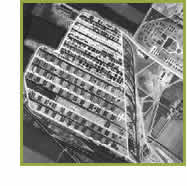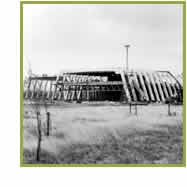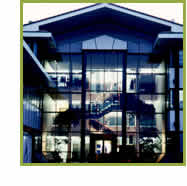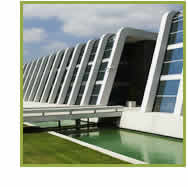How can industry be classified?
There are four types of industry. These are primary, secondary, tertiary and quaternary.
Primary industry involves getting raw materials e.g. mining, farming and fishing.
Secondary industry involves manufacturing e.g. making cars and steel.
Tertiary industries provide a service e.g. teaching and nursing.
Quaternary industry involves research and development industries e.g. IT.
Industrial Systems
Factories have inputs, processes and outputs. Inputs can be the raw materials need to make something. Inputs can also be labour, buildings, capital and machinery. Processes are the things which go on within the factory. This is usually the manufacturing of goods. It can also be design and research - anything needed to make something. Outputs are the things which leave the factory. This can include the finished product, profit or even waste.
What affects the location of industry?
There are many factors which affect the location of industry. These include raw materials, labour supply, markets, transport and Government Policy.
Multinational Companies
MNCs or Multinational companies are large companies which are located in more than one country. Examples include Coca Cola and Nike.
What is a footloose industry? Footloose industries are those that do not have to locate close to raw materials (unlike the early iron and steel industry that had to locate close to iron ore and coal etc). Footloose industries locate in pleasant environments near transport routes and near the markets. An example of a footloose industry would be a hi-tech industry such as computing. Footloose industries have to locate close to research centres like universities. Development in the hi-tech industry happen so fast that companies need to stay up to date to survive e.g. Science Parks around Cambridge. Footloose industries are usually non-polluting and can locate close to residential areas. What is the Hi-Tech Industry?
A High technology (Hi-tech) industry is one that produces sophisticated products. There is a significant emphasis on research and development. Often the 'raw materials'
Science Parks Science Parks are located on the edge of cities in greenfield locations. Many of the firms located in science parks are connected with information, high-technology, and electronic industries. Science parks have direct links with universities for research. They have attractive layouts with grassy areas, ornamental gardens, ponds etc. An example is The Cambridge Science Park. The Cambridge Science Park The Cambridge Science Park is on the edge of Cambridge, alongside the M11 and the A10. It is located here because it is very accessible, land values are lower on the edge of an urban area and there is plenty of open space for expansion. A number of companies have links with research departments at Cambridge University. You can find out more about the Cambridge Science Park here. |
|
Cambridge Science Park
Established by Trinity College in 1970, Cambridge Science Park is the UK's oldest and most prestigious science park.
Now home to 71 hi-tech companies and 5,000 personnel, Cambridge Science Park continues to attract new businesses, from small start-ups and spin-outs to subsidiaries of multinational corporations
Company Directory: Quicklist
The companies currently located on the Science Park are listed below. Click a company name to view information about that company, including any job vacancies or press releases they have submitted.
History
|
|||
|
|||
|
|
|
|
|
|||
|
|||
The Science Park Story

The land where the Cambridge Science Park is located, on the north-eastern edge of the City of Cambridge, has belonged to Trinity College since its foundation by King Henry VIII in 1546. It was farm land until World War II when it was requisitioned by the US Army and was used to prepare vehicles and tanks for the D-Day landings in Europe. After the war, the site lay largely derelict and increasingly threatened by planning blight until the decision to develop it was taken in 1970.
The development was a response to a report by the Mott Committee, a special Cambridge University Committee set up under the Chairmanship of Sir Nevill Mott (then Cavendish Professor of Experimental Physics) to consider an appropriate response from Cambridge to an initiative of the Labour government following its election in 1964. Whitehall had urged UK universities to expand their contact with industry with the objective of technology transfer and also to increase the payback from investment in basic research and an expansion in higher education, in the form of new technologies.
The Mott Committee, in its report published in 1969, recommended an expansion of 'science-based industry' close to Cambridge to take maximum advantage of the concentration of scientific expertise, equipment and libraries and to increase feedback from industry into the Cambridge scientific community.
Trinity College was impressed with the importance of these ideas. The College had a long tradition of scientific research and innovation from Sir Isaac Newton onwards and since it had a piece of land available, it decided to apply for planning permission to develop it as a science park, an idea born during the 50s in the USA where the first science park was established by Stanford University.
The first decade - 1970-80
Outline planning permission was granted in October 1971 and the first company, Laser-Scan, moved onto the site in Autumn 1973 following clearance and landscaping of the derelict area, conversion of the old gravel pit dug for wartime concrete standings into a lake and construction of the first stretch of road. 
The growth of the Cambridge Science Park was slow in the first five years. The science park concept was an unfamiliar one and companies were mainly attracted to it by a desire to be close to the University's scientific research. Early on, UK subsidiaries of multinational companies started to locate there (LKB Biochrom from Sweden and US laser specialists Coherent were the first two of these) and the number of companies slowly grew to 25 by the end of the 70s.
The second decade - 1980-90
By the early 80s, a mini-cluster of technologies and people had developed and this, plus the attractions of Cambridge as a centre for research, began to draw in more companies. A period of strong growth followed and the Trinity Centre was opened in 1984 to provide a meeting place, meal facilities and conference rooms for the increasing number of people working at the park. More starter units and the Cambridge Innovation Centre were built to expand the range of accommodation available and a squash court was opened in 1986. 
During the 80s, several venture capital companies opened offices on the park, including the regional office of 3i, the UK's leading venture capital company. In the second half of the decade, University academics began to bring companies to the park, encouraged by its success and also because of the breaking in the mid-80s of BTG's monopoly of intellectual property originating in UK universities.
The Cambridge Science Park also began to accommodate spin-outs from existing tenant companies such as Cambridge Consultants, and saw the first collaborative venture formed by park companies - Qudos, which was founded by the University's Microelectronics Laboratory (which was then located at the park), Prelude Technology Investments and Cambridge Consultants.
The third decade - 1990-1999
The 1990s saw many changes in the Cambridge hi-tech and science park scene. The cluster of hi-tech companies in the Cambridge area grew to some 1200 companies employing around 35,000 people and demand for space increased. Incubators for start-ups were established elsewhere in Cambridge and the supply of venture capital in the UK and from locally established venture funds had increased dramatically. 
Fast growing internet and telecoms-related companies and the growth and success of a number of companies which had been at the Park for some years, altered the pattern of space occupation. However towards the end of the 1990s the life sciences sector started to grow and become the dominant technology sector on the Park.
There were now fewer but larger, better funded and more successful companies at the park and more of them were launched onto the UK Stock Exchange. A biotech venture capital fund, Merlin Ventures, opened an office on the Park. However, the origins of companies arriving were much the same as in the past: a mixture of spin-outs, developing new ventures from the Cambridge area and elsewhere in the UK, and UK subsidiaries of multinational companies. By December 1999, there were 64 companies at the Park employing some 4,000 people.
The twenty-first century
The new century has begun with many exciting developments on the Cambridge Science Park.
A joint venture between Trinity College and another Cambridge College - Trinity Hall (which owns the adjacent land) will complete the remaining 22.5 acres of brown field development land adjacent to the Park. Five bespoke buildings of between 29,000 sq ft of 36,000 sq ft have
been designed, built and pre-let.
In September 2000, the Q.ton forum opened, accommodating a new conference centre, restaurant and bar. A new fitness centre also opened - the Q.ton Revolution. In 2001, a 115 place child care nursery was built providing a valuable resource for parents on the Park. Other benefits also brought onto the Park included 5 broadband services, a park-wide CCTV system and bus service.
Dr Jeremy Fairbrother - Senior Bursor Trinity College and Director Cambridge Science Park
Since 2002, the creation of new clusters has begun on the Cambridge Science Park, specifically in the areas of photonics, nanotechnology and materials science. In particular the strength of the photonics cluster is demonstrated by the arrival on the Park of Cambridge University's Centre of Molecular Materials for Photonics and Electronics (CMMPE). The centre was opened by Lord Sainsbury, the Minister for Science and Technology in February 2003.
Lord Sainsbury in his address at the launch of CMMPE said "Photonics will be to the next 20 years what electronics has been in the past 20".
The Centre represents another major milestone in the relationship between industry and academia and the prospect of further exciting development ahead for the Cambridge Science Park.
Wyszukiwarka
Podobne podstrony:
Applications and opportunities for ultrasound assisted extraction in the food industry — A review
System industrialny Saint-simona, Współczesne Idee Polityczne
Leeds industrial trail
75 1067 1073 Elimination of Lubricants in Industries in Using Self Lubricating Wear Resistant
The?fects of Industrialization on Society
3 Industry 4, Silicon?n
INDUSTRIAL ROBOTS
Znaczenie relacji z klientem w erze przed industrialnej było na wysokim poziomie
61 881 892 Evaluation of PVD Coatings for Industrial Applications
4 Koncepcje przestrzeni Indust Nieznany
application of solid state fermentation to food industry a review
Oil Industry
industrial strength
78 1101 1109 Industrial Production of Tool Steels Using Spray Forming Technology
eBooks PL Kuchnia 21 Encyklopedia Sztuki Kulinarnej Tarty I Pizze (Industrial Usagi) (osiol NET) (2
oee industry standard
Kr 018 Biblijne proroctwa na temat ewolucjonizmu Ćmy w industrialnej Anglii jako dowód ewolucji pię
The?onomic Underpinnings of the First British Industrial R
Economics 6 INDUSTRIAL LOCATION
3 Industry 2 Fordism, Post fordism
więcej podobnych podstron